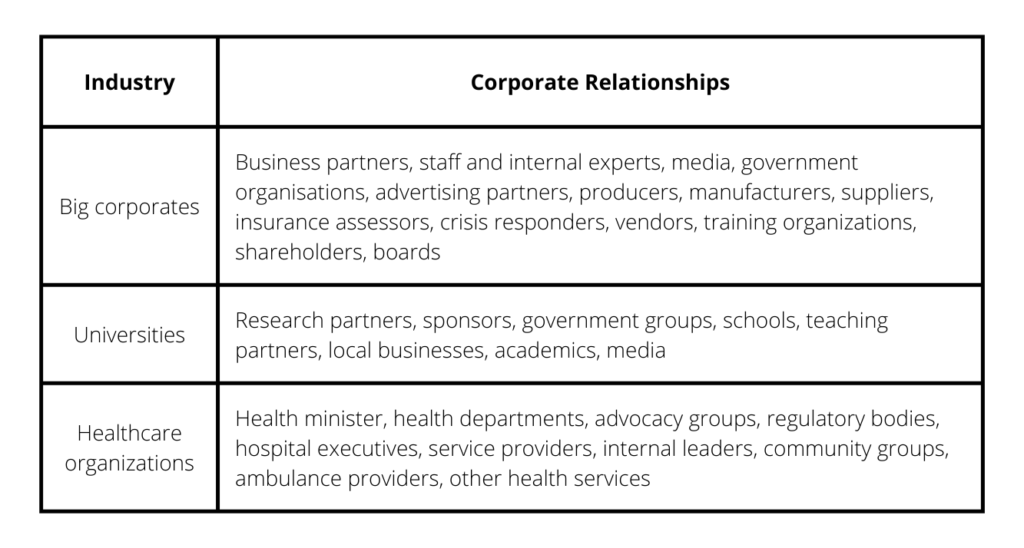Corporate Relationship Management: When Asana & Spreadsheets Don’t Cut It Anymore

Every organization has relationships that they need to manage in order to achieve their goals or meet their obligations. For some small businesses, it’s as simple as maintaining a handful of client, employee, and supplier relationships.
But for larger corporations, more complex corporate relationship management is required. Not only because the potential risks and rewards are higher, but because the relationships are more complex (and more likely to be long-term). You can add substantial value to your organization from managing relationships well, but you’ll need to be equipped with the right processes and tools for the task.
So, let’s take a closer look at corporate relationship management, what it is (and isn’t), and some of the different tools used to manage complex business relationships.
What Is Corporate Relationship Management?
Corporate relationships management is a type of stakeholder relationship management that focuses on managing important (and often complex) business relationships and partnerships. Other terms you may come across include:
- Business relationship management
- Enterprise relationship management
- Partner relationship management
- Supplier relationship management
- Stakeholder relationship management
It involves a process of identifying which relationships are critical to your organization, seeking to understand those individuals and entities, and putting processes in place to strategically engage, manage, and communicate with these stakeholders. Usually, with the goal of adding value and managing risk — often over a long period of time.
Here are some examples of industries that typically manage complex relationships:

But this approach can also be particularly beneficial when applied to cross-cultural collaboration and communication (especially when face-to-face isn’t possible). And it can also add value to large, complex projects that depend on successful relationships with clients, design teams, contractors, suppliers, and government groups.
What Isn’t Corporate Relationship Management?
Corporate relationship management is most commonly confused with customer relationship management. But customer relationship management is about customers — both existing and potential — and is mainly focused on sales. The overall goal of customer relationships management is to increase sales — both short term and long term.
Corporate relationship management is about business relationships — people who aren’t necessarily customers, but can contribute value to the business (or impact it) in some way. This includes strategic partners, employees, shareholders, boards, distributors, and suppliers. Plus anyone else that the organization may need to collaborate with, communicate with, and share information with.
Why Do Corporate Relationship Management Well?

The practice of corporate relationship management is increasingly important in the fast-paced internet age, where a more rapid exchange of knowledge and stronger relationships can uncover opportunities and drive value for organizations.
But in many ways, this has always been the case: no organization exists on its own, but as part of a complex web of relationships — business and otherwise. These relationships can be a source of risk or opportunity. Understanding those relationships can help you be strategic about who you engage with, how you approach them, when, and how often.
This drive value, uncover opportunities, and manage risk by enabling you to:
- Build stronger relationships with people and organizations critical to your outcomes
- Optimize resources to focus on the right relationships at the right time
- Develop greater transparency and visibility which can build mutual trust and shared understanding
- Enable faster, more coordinated responses to a crisis situation
- Collaborate or facilitate more efficient ways of working together
- Tap into specific expertise held by internal and external contacts
- Share and create knowledge
- Anticipate potential issues that may come up in the relationship
- More effectively manage expectations
- Communicate more consistently and respond quickly and appropriately
- Solidify rules and establish boundaries
- Resolve disputes or negotiate contracts
- Explore cross-sale opportunities
- Manage and demonstrate corporate governance
Maintaining good relationships is clearly a good idea. But how do you actually effectively build and maintain relationships? What does corporate relationships management look like in practice?
(5) Steps to Managing Complex Corporate Relationships
Most organizations use the following process to manage corporate relationships:
Step 1: Set Goals
Start by identifying your goals. What do you want to achieve by strategically managing relationships in your organization? Get specific about the value you hope to add, as this will help you justify any required investment to support your relationship management plan.
Step 2: Identify Relationships
What relationships already exist that you need to manage? What other relationships could you build that don’t yet exist? What do you know about these individuals or groups? Assign characteristics like business value, role, sector, location, influence, interests, motivations, impact, knowledge, issues, contact/engagement preferences, and more.
You can use stakeholder analysis and stakeholder mapping methods to better understand each individual and (if needed) group individuals with similar characteristics so that they’re easier to manage and prioritize. Or apply these five simple steps to getting started with stakeholder data management.
Step 3: Planning and Processes
Plan how you’ll track and monitor your corporate relationships. What platforms will you reach them on? What issues do you need to keep them informed on? How often do you need to stay in touch? Who else in your organization should be part of this process?
You’ll need a way to retain knowledge and document processes so that you can ensure continuity of business relationships even if team members move on to other roles.
Step 4: Relationship Management, Communication, and Nurturing
Nurture and communicate with your corporate partners in line with your plan. This might involve:
- Establishing a relationship via an initial meeting or discussion
- Seeking connection outside of work via meetings and social events
- Keeping people up to date on discussions and developments that impact them (or that may benefit from their input)
- Looking out for points of tensions
- Monitoring for change to ensure continuity of relationships as executives and managers come and go
- Documenting each person’s contact details, characteristics, interactions, feedback, responses, and follow up tasks inside a stakeholder information system
- Facilitating newsletter subscriptions, segmented mailing lists, opt-ins, and opt-outs
Step 5: Feedback and Reporting
It’s important to get regular feedback to understand how you’re going and adjust your approach if needed. Use the analysis to explore questions like…
Is this person happy? Do they have an issue that requires additional support or management? How is the relationship changing? What overall trends are you noticing? How many interactions do you have within a specific time period, for certain groups (e.g. role or sector), and for each organization? Who do you need to focus on next?
Report on your progress to demonstrate how you’re tracking with managing relationships, managing risk, and adding value to the business.
(4) Corporate Relationship Management Tools
Most organizations use one of the following tools to track and report on their corporate relationships — each with different features, benefits, and limitations.
1. Spreadsheets
Spreadsheets are used to organize data. The best known spreadsheet tools are Microsoft Excel and Google Sheets.
The biggest advantage of using spreadsheets for corporate relationship management is that they’re free (or very low cost). They also require almost no training for anyone on your team to use them. Spreadsheets are also highly customizable — you can easily import most types of data and analyze it using charts and formulas.
But they’re also very limited on features, especially when you look at:
- Sharing – Because many users will download the sheet (instead of working from shared cloud-based access), it could lead to duplicate copies with inconsistent data
- Security – There’s a security risk if you have spreadsheets with contact records stored in various email attachments, folder systems, and devices
- Usability – They can be really clunky to use, especially when you want to import a lot of data for each contact
- Interactivity – Unlike more sophisticated tools, they lack interactive features like task management, alerts, conversations, automatic data imports, analysis, and more
Learn more about the four reasons you should leave spreadsheets behind.
2. Project Management Software
Project management software is designed to organize, manage, and schedule projects. They can be used for team collaboration, setting priorities and deadlines, tracking time, managing budgets, documenting progress/discussions, and sharing documents. Popular platforms include Asana, Trello, Jira, Monday and Basecamp.
There are benefits of using PM software to support corporate relationship management. You may already have a system in place that you use to manage projects, which means that your team is already familiar with the system (and you already have an active license). They typically have strong scheduling, task management, and collaboration features, which can help your team work together and stay on track with specific tasks relating to your corporate stakeholders.
But you will likely also run into a number of roadblocks with this type of system because people are not projects.
Project management software is designed for managing projects — usually with a start, middle, and end. It isn’t designed to manage relationships (outside of allocating work to your project team) and will generally have limited capabilities for recording data about your contacts.
It might be possible to get away with recording details for one or two simple relationships in your PM software, but anything more complex than that will quickly get out of hand.
3. CRMs (Customer Relationship Management Software)
CRMs or Customer Relationship Management software is used to manage interactions and relationships with existing, previous, and potential customers. It often forms part of sales, and is used to manage contact information, track the sales pipeline, send email promotions (or tailored emails), record sales data and billables, and monitor interactions with each customer (often integrating interactions from email, phone calls, and social media). Popular CRMs include Salesforce, HubSpot, Dynamics, Zendesk, and Zoho.
Some organizations use a CRM to track and manage corporate relationships alongside their customer relationships. CRMs are designed for relationship management, so they’re typically good at recording detailed contact information and interactions. They often have built-in task management for following up with specific contacts, and enable team collaboration.
However, many larger organizations will eventually run into issues if they rely on a CRM for managing complex relationships for the following reasons:
- Sales focus – Because CRMs are built to support sales their features can get in the way of your core goal (to build long-term relationships and value)
- Mixing relationships – A handful of strategic corporate relationships can easily get lost amongst a massive list of customer contacts
- Limited analysis – CRMs are designed to generate analyses from a sales perspective, and generally have limited capabilities when it comes to identifying issues, interests, impact, and sentiment
To sum it up: CRMs might be able to record contact information, but they fall short when it comes to analyzing more complex relationships and managing them.
4. SRMs (Stakeholder Relationship Management Software)

Increasingly, larger organizations are turning to stakeholder relationship management (SRM) software to manage complex relationships. SRMs are a little bit like CRMs, but instead of being designed to support the sales process, an SRM is specifically designed for:
- Organizing, analyzing, and categorizing stakeholders
- Monitoring and nurturing relationships
- Supporting communication and engagement
- Managing complaints and issues
- Reporting on progress and activities
Examples of stakeholder relationship management tools include Simply Stakeholders, Darzin, Borealis, and Staketracker.
Compared to spreadsheets, project management software, and CRMs, a stakeholder relationship management tool offers a number of features and benefits specific to corporate relationship management. This includes:
- Managing all types of business relationships (not just customers)
- Creating a secure, single source of truth with visibility into your key contacts and interactions
- Facilitating a team-based approach to relationship management
- Standardizing your approach to managing business relationships
- Segmenting contacts and managing them according to their interest, impact, and influence (as well as other characteristics like location, sector, company, and role)
- Managing individual preferences for different communication frequencies and engagements (e.g. phone, email, LinkedIn, Zoom, or in-person)
- Supporting an engagement process, rather than a sales pipeline
- Integrating interactions via email, social media, and text messaging to inform future interactions
- Facilitating appropriate, timely responses to questions and comments
- Assessing and reporting on how effectively you’re managing relationships (and segmenting these reports according to different stakeholder groups and attributes)
All these benefits come down to one thing: SRMs are specifically designed to manage complex relationships.
Learn more about the difference between CRMs and SRMs.
Of course, an SRM isn’t for everyone. Mainly because it means another piece of software your team needs to learn (and you need to subscribe to). But if you need to manage complex corporate relationships and your other tools just aren’t cutting it, the features can enable better efficiency and outcomes — making it well worth the extra investment and training.
Simplify Complex Relationship Management with Simply Stakeholders
Corporate relationship management can form part of project management, but it is so much more than a project or task list. And since it’s not a function of sales, trying to manage corporate partners alongside customers in your CRM is likely going to fail.
Instead, best practice corporate relationship management requires a stakeholder relationship management tool like Simply Stakeholders.
With Simply Stakeholders, you can simplify complex relationships using our built-in contact records, stakeholder analysis, sentiment tracking, interactions, task management, reporting, and much more.
Take a look at how our stakeholder software works or contact us to request a demo.






























